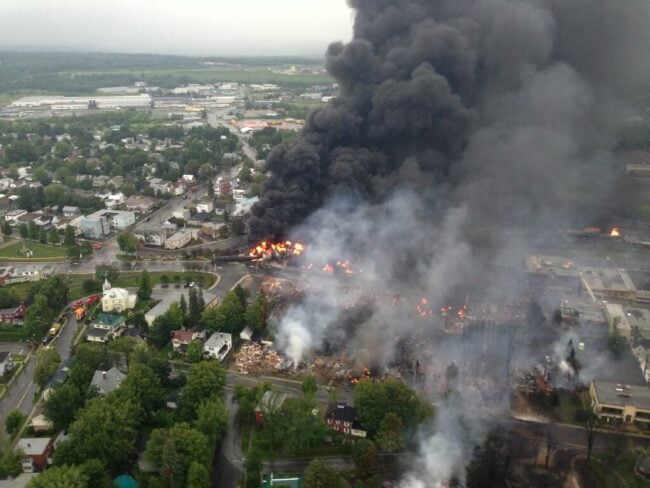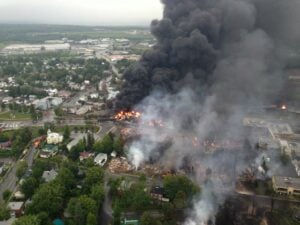Bomb trains and their devastating effects

Bakken Crude oil train derailment in Lac Magantic Quebec, 2013. Photo by Sûreté du Québec via Wikimedia Commons
View more images on our Flickr site
Following the catastrophic February third train accident in East Palestine, Ohio, Riverkeeper joined with partners Earthjustice, Waterkeeper Alliance, Sierra Club, and Washington Environmental Council in issuing a letter to Department of Transportation (DOT) Secretary Pete Buttigieg. The February 2023 letter referenced a 2018 administrative appeal submitted by these groups, concerning the DOT’s repeal of a rule that would increase brake safety measures on certain high-hazard flammable unit trains. Though the DOT was required to respond to the 2018 appeal within 90 days, the appeal went unanswered.
HHFUTs and Electronically Controlled Pneumatic (ECP) Brakes
In May 2015, the DOT’s Pipeline and Hazardous Materials Safety Administration (PHSMA), in coordination with the Federal Railroad Administration (FRA), adopted a rule that required high-hazard flammable unit trains (HHFUTs) to have electronically controlled pneumatic (ECP) brake systems when traveling faster than 30 mph. HHFUTs are trains that have 70 or more train cars loaded with flammable liquids.
Unfortunately, within just a few months of this new rule being adopted, Congress passed a bill which instructed the FRA to re-study the efficacy and costs of ECP brake systems and the FRA wrongly determined that the benefits of the ECP brake systems, including safer rail travel and less harm to people and the environment, did not outweigh the costs. At the peril of communities and environmental threats, the ECP brake requirement was rescinded.
According to data compiled by USA Today from federal reports, in 2022 alone, rail operators reported 337 hazardous material leaks or spills. Railroad derailments accounted for 1 in 10 hazmat wrecks in the last decade—and 1 in 4 of those incidents in the last year.

Bakken Crude oil train derailment in Lac Magantic Quebec, 2013. Photo by Sûreté du Québec via Wikimedia Commons
In recognizing the devastating impacts caused by accidents from trains carrying toxic materials and high-hazard flammable unit trains, Riverkeeper has continued the fight to increase the safety standards.
Yet, both Riverkeeper and our elected officials were largely stonewalled by the railroads when we called for a range of safety retrofits and infrastructure upgrades to both freight rail cars and the bridges and tracks they travel over in recent years, most notably during the peak of crude oil shipments from the Bakken oil producing region through the Hudson Valley on the way to coastal refineries. During the crude-by-rail boom, the country witnessed several large scale derailments and massive explosions as these nearly mile-long unit trains carried volatile Bakken crude oil in outdated and inadequate DOT 111 cars more suited for transporting non-hazardous products.
The Ohio derailment and chemical release is a fresh reminder of the risks we face in the Hudson Valley and in New York State from freight trains carrying a range of products through numerous localities and along the shores of the Hudson River. A derailment like the one in Ohio would be a catastrophe for the river, since spill response, including containment and recovery, to a similar accident is near impossible in a moving water system like the tidal Hudson. Our efforts focus on new federal regulations that require railroad operators to answer to the public and their elected officials, instead of only to themselves.
Appealing the DOT’s Repeal
In the 2018 appeal, Riverkeeper and partners raised three issues: notice-and-comment rulemaking violations, reliance on an out-dated and inappropriate regulatory impact analysis, and violation of the FAST Act’s study requirements. First, PHMSA acted unlawfully by issuing and making the repeal effective immediately, without affording the public an opportunity to comment. Second, at the time of the appeal, recent crude-by-rail traffic data contradicted the DOT’s lowering of the estimates used in the updated Regulatory Impact Analysis (RIA). In the 2017 updated RIA, the DOT conceded that its fleet forecast and assessment of benefits could become outdated, and one year later, the data had proven that concession accurate. Last, the DOT failed to comply with the FAST Act’s testing requirements, specifically the testing to be completed by the National Academy of Sciences (NAS).
To rectify these wrongs, we sought to vacate the October 2017 updated RIA and the September 2018 PHMSA repeal of the May 2015 ECP brake system requirement.
DOT’s Recent Response
In this most recent letter sent to the DOT, we sought assurances that the DOT would provide an expeditious response, including a timeline for such a response. Within a week, the DOT indicated its intent to take action, albeit partially, in response to our concerns. Secretary Buttigieg called on the rail industry to take immediate, commonsense steps to improve accountability and safety, while highlighting ways that Congress could support those efforts. In particular, Buttigieg’s statement noted that the DOT would be “pursuing further rulemaking, to the extent possible under current statute, on high-hazard flammable trains (HHFT) and electronically controlled pneumatic brakes (ECP).” While this is certainly a step in the right direction, Riverkeeper and partners will continue to ensure the DOT’s actions match its words.
As Kristen Boyles of Earthjustice stated: “We welcome today’s announcement, but we cannot rely on voluntary change from the railroads — DOT and Congress need to move quickly to protect communities and the environment from another disaster.”
To stay informed on this and other campaigns, please sign-up for updates here >
